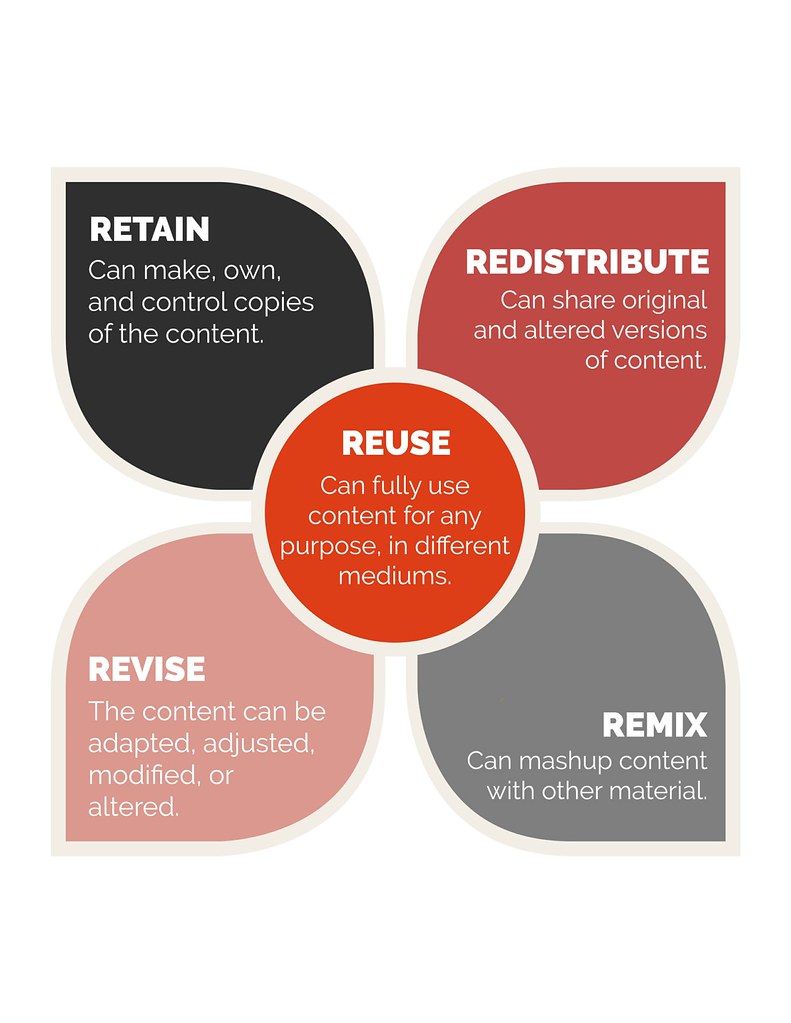
What are Open Educational Resources (OER)?
The William and Flora Hewlett Foundation defines open educational resources (OER) “are teaching, learning and research materials in any medium – digital or otherwise – that reside in the public domain or have been released under an open license that permits no-cost access, use, adaptation and redistribution by others with no or limited restrictions.”
Defining the "Open" in Open Content and Open Educational Resources
The terms "open content" and "open educational resources" describe any copyrightable work (traditionally excluding software, which is described by other terms like "open source") that is either (1) in the public domain or (2) licensed in a manner that provides everyone with free and perpetual permission to engage in the 5R activities:
This material is an adaptation of Defining the "Open" in Open Content and Open Educational Resources, which was originally written by David Wiley and published freely under a Creative Commons Attribution 4.0 license at http://opencontent.org/definition/.
<p><iframe allow="accelerometer; autoplay; encrypted-media; gyroscope; picture-in-picture" allowfullscreen="" frameborder="0" height="409" src="https://www.youtube.com/embed/gJWbVt2Nc-I" width="727"></iframe></p>
To understand the conditions under which an open educational resource is available for use and/or modification, look for the assigned license, which will likely be a Creative Commons license. For more information about Creative Commons Licenses, visit the "About the Licenses" page of the Creative Commons website (https://creativecommons.org/licenses/) or check out the video (below), from Open Oregon Educational Resources.
Why Use OER?
To increase access to higher education
By making sure that each course includes all of the course materials and resources that students need, we are putting all students on the same level. Each student has equal access to the same information, ensuring fairness and equality among all students enrolled in the OER course.
To make higher education more affordable
By eliminating the burden of additional textbook costs for students, the actual cost of taking an OER course is reduced. Often, this is a significant reduction in cost which translates to considerable savings over time. This can result in much lower student debt, making attaining the Bachelor Degree easier and more valuable.
To increase student success
By giving all students in an OER course equal access, and removing the burden of additional expenses to those who can least afford them, students have a better chance of being successful in the course, continuing their enrollment, and achieving their academic goals.
Some material excerpted from the presentation description for, The OER Trifecta: Access, Affordability and Student Success presented by Dr. Wm. Preston Davis for WCET on Nov 21, 2014.

Graphical representation of the 5 R's of OER, designed by graphic artist Kiersten Merkel, for the Auraria Library, for inclusion in the OER Bazaar exhibit at COLTT17 (Colorado Online Learning and Teaching with Technology.)
https://creativecommons.org/licenses/by/3.0/us/